Project Management Report: IMS Development for Client Organization
VerifiedAdded on 2023/06/10
|14
|3326
|309
Report
AI Summary
This report presents a comprehensive project management plan for the development and implementation of an Information Management System (IMS) for a client organization. The introduction outlines the project's goal of automating information handling. The report details the project overview, key functionalities, and expected timeline, including a work breakdown structure and key deliverables. It covers resources and budget planning, scope management, acceptance criteria, and stakeholder analysis. Furthermore, it includes a risk assessment plan and a communication management strategy, emphasizing project control. The report also contains a lessons learned report, concluding with key insights and experiences gained throughout the project lifecycle. The report covers various aspects like project planning, execution, and control, making it a comprehensive guide for managing the IMS project.
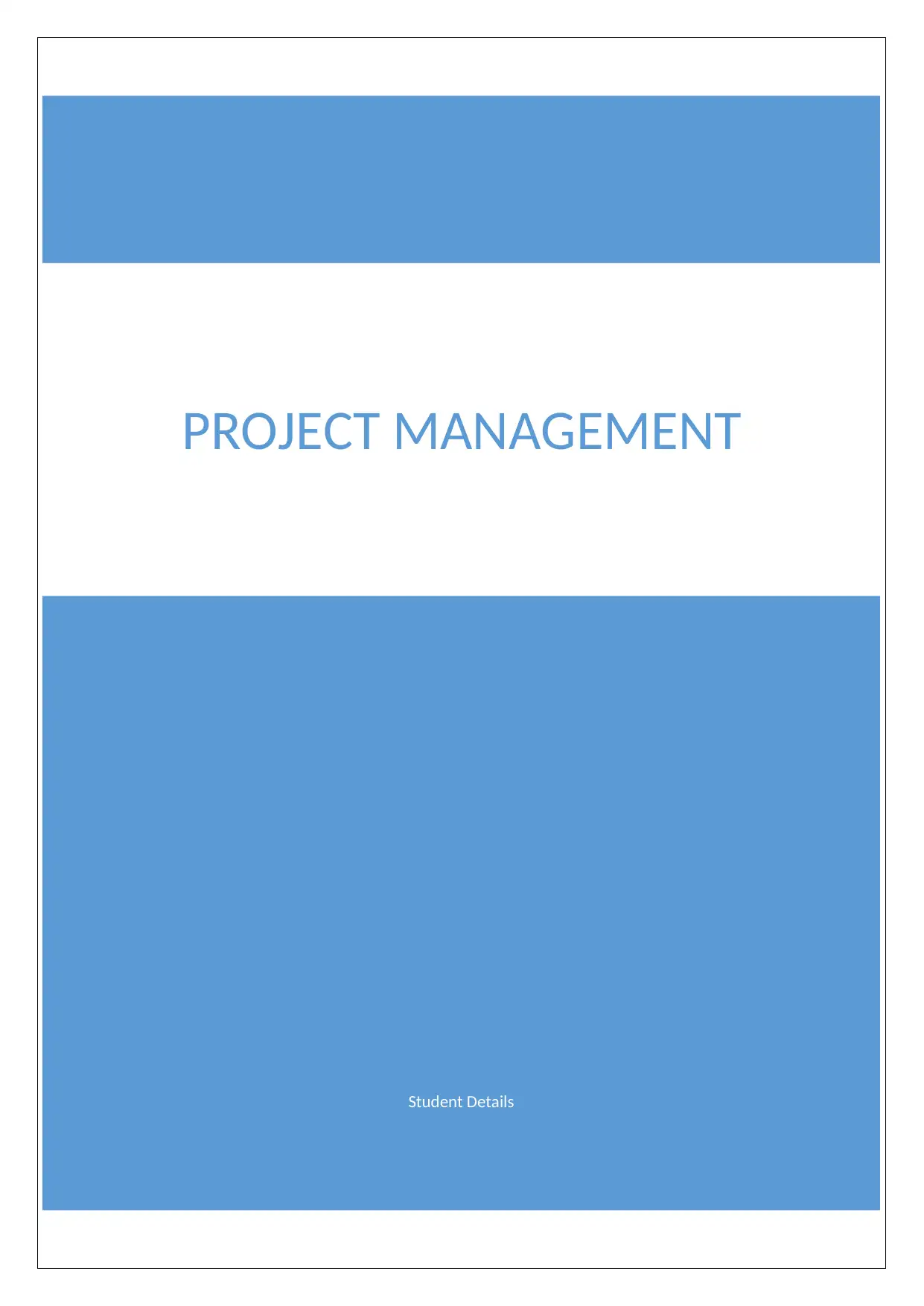
Student Details
PROJECT MANAGEMENT
PROJECT MANAGEMENT
Paraphrase This Document
Need a fresh take? Get an instant paraphrase of this document with our AI Paraphraser

Contents
Introduction................................................................................................................................1
Project management Plan...........................................................................................................1
Project Overview:...................................................................................................................1
Key Functionalities of the IMS:.............................................................................................1
Project Schedule:....................................................................................................................1
Expected Timeline:.............................................................................................................1
Work Breakdown Structure and Detailed Timeline...............................................................1
Key Deliverables for the project.............................................................................................2
Resources and Budget Planning:............................................................................................2
Project Scope Management Plan............................................................................................2
Acceptance criteria:................................................................................................................3
Stakeholder Register...............................................................................................................3
Risk Assessment Plan.............................................................................................................4
Communication Management and Project Control....................................................................5
Communication management and the project flow:...............................................................5
Essential Elements for a communication plan:......................................................................6
Lesson Learned Report..............................................................................................................6
Conclusion:.............................................................................................................................7
1
Introduction................................................................................................................................1
Project management Plan...........................................................................................................1
Project Overview:...................................................................................................................1
Key Functionalities of the IMS:.............................................................................................1
Project Schedule:....................................................................................................................1
Expected Timeline:.............................................................................................................1
Work Breakdown Structure and Detailed Timeline...............................................................1
Key Deliverables for the project.............................................................................................2
Resources and Budget Planning:............................................................................................2
Project Scope Management Plan............................................................................................2
Acceptance criteria:................................................................................................................3
Stakeholder Register...............................................................................................................3
Risk Assessment Plan.............................................................................................................4
Communication Management and Project Control....................................................................5
Communication management and the project flow:...............................................................5
Essential Elements for a communication plan:......................................................................6
Lesson Learned Report..............................................................................................................6
Conclusion:.............................................................................................................................7
1

Introduction
The IMS project under consideration intends to automatize the information handling
operations within the client organization. The IMS project will be able to store, analyze and
then use the information stored in the organization or potential business knowledge that can
help the organization to optimize their business activities. This report intends to detail a
project management plan along with certain other elements including WBS, Communication
plan, scope and stakeholder analysis etc. for a better understanding of the of the project’
implementation process. Towards the end, a Lessons learned report will be generated in order
to highlight the key lessons or experiences gained from this project.
Project management Plan
Project Overview:
The undertaken project aims to develop an IT system or IMS for the client organization. The
key focus behind the development of the IMS is to bring in automation in the daily process
and operations of the organization. The target IMS will be used to replace their manual user
information system. Further, the IMS will allow the client organization to carry out a detailed
analysis in the information stored in the IMS and then use the same information for further
business process optimization.
Key Functionalities of the IMS:
The target project intends to handle all the core operations of the client organization.
Following is the brief description of the same:
o User Data and Account Management
o Business Orders, Financial Structure, and transaction management.
o Inventory Management
o Client Support and Service to the customers(Dalcher, 2014)
Project Schedule:
Expected Timeline:
Project Oriented:
Targeted milestone Time period
Development and Deployment of the
application
80 days
Training and documentation for the
developed application
10 days
Business-oriented:
Targeted Milestone Time period
Potential Increase in the customer base for
the client organization
12 months
Increased ROI 18 months
2
The IMS project under consideration intends to automatize the information handling
operations within the client organization. The IMS project will be able to store, analyze and
then use the information stored in the organization or potential business knowledge that can
help the organization to optimize their business activities. This report intends to detail a
project management plan along with certain other elements including WBS, Communication
plan, scope and stakeholder analysis etc. for a better understanding of the of the project’
implementation process. Towards the end, a Lessons learned report will be generated in order
to highlight the key lessons or experiences gained from this project.
Project management Plan
Project Overview:
The undertaken project aims to develop an IT system or IMS for the client organization. The
key focus behind the development of the IMS is to bring in automation in the daily process
and operations of the organization. The target IMS will be used to replace their manual user
information system. Further, the IMS will allow the client organization to carry out a detailed
analysis in the information stored in the IMS and then use the same information for further
business process optimization.
Key Functionalities of the IMS:
The target project intends to handle all the core operations of the client organization.
Following is the brief description of the same:
o User Data and Account Management
o Business Orders, Financial Structure, and transaction management.
o Inventory Management
o Client Support and Service to the customers(Dalcher, 2014)
Project Schedule:
Expected Timeline:
Project Oriented:
Targeted milestone Time period
Development and Deployment of the
application
80 days
Training and documentation for the
developed application
10 days
Business-oriented:
Targeted Milestone Time period
Potential Increase in the customer base for
the client organization
12 months
Increased ROI 18 months
2
⊘ This is a preview!⊘
Do you want full access?
Subscribe today to unlock all pages.

Trusted by 1+ million students worldwide
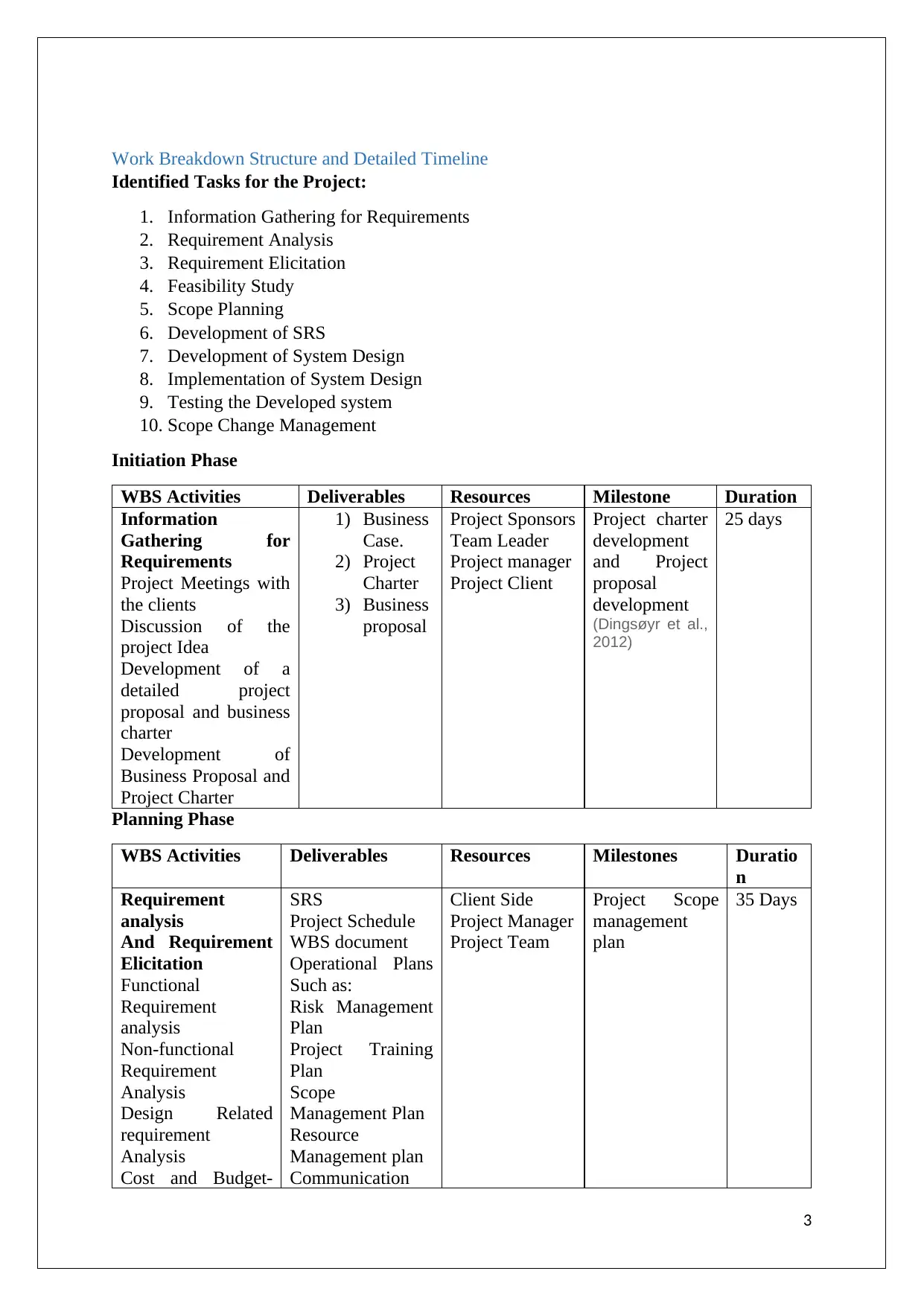
Work Breakdown Structure and Detailed Timeline
Identified Tasks for the Project:
1. Information Gathering for Requirements
2. Requirement Analysis
3. Requirement Elicitation
4. Feasibility Study
5. Scope Planning
6. Development of SRS
7. Development of System Design
8. Implementation of System Design
9. Testing the Developed system
10. Scope Change Management
Initiation Phase
WBS Activities Deliverables Resources Milestone Duration
Information
Gathering for
Requirements
Project Meetings with
the clients
Discussion of the
project Idea
Development of a
detailed project
proposal and business
charter
Development of
Business Proposal and
Project Charter
1) Business
Case.
2) Project
Charter
3) Business
proposal
Project Sponsors
Team Leader
Project manager
Project Client
Project charter
development
and Project
proposal
development
(Dingsøyr et al.,
2012)
25 days
Planning Phase
WBS Activities Deliverables Resources Milestones Duratio
n
Requirement
analysis
And Requirement
Elicitation
Functional
Requirement
analysis
Non-functional
Requirement
Analysis
Design Related
requirement
Analysis
Cost and Budget-
SRS
Project Schedule
WBS document
Operational Plans
Such as:
Risk Management
Plan
Project Training
Plan
Scope
Management Plan
Resource
Management plan
Communication
Client Side
Project Manager
Project Team
Project Scope
management
plan
35 Days
3
Identified Tasks for the Project:
1. Information Gathering for Requirements
2. Requirement Analysis
3. Requirement Elicitation
4. Feasibility Study
5. Scope Planning
6. Development of SRS
7. Development of System Design
8. Implementation of System Design
9. Testing the Developed system
10. Scope Change Management
Initiation Phase
WBS Activities Deliverables Resources Milestone Duration
Information
Gathering for
Requirements
Project Meetings with
the clients
Discussion of the
project Idea
Development of a
detailed project
proposal and business
charter
Development of
Business Proposal and
Project Charter
1) Business
Case.
2) Project
Charter
3) Business
proposal
Project Sponsors
Team Leader
Project manager
Project Client
Project charter
development
and Project
proposal
development
(Dingsøyr et al.,
2012)
25 days
Planning Phase
WBS Activities Deliverables Resources Milestones Duratio
n
Requirement
analysis
And Requirement
Elicitation
Functional
Requirement
analysis
Non-functional
Requirement
Analysis
Design Related
requirement
Analysis
Cost and Budget-
SRS
Project Schedule
WBS document
Operational Plans
Such as:
Risk Management
Plan
Project Training
Plan
Scope
Management Plan
Resource
Management plan
Communication
Client Side
Project Manager
Project Team
Project Scope
management
plan
35 Days
3
Paraphrase This Document
Need a fresh take? Get an instant paraphrase of this document with our AI Paraphraser
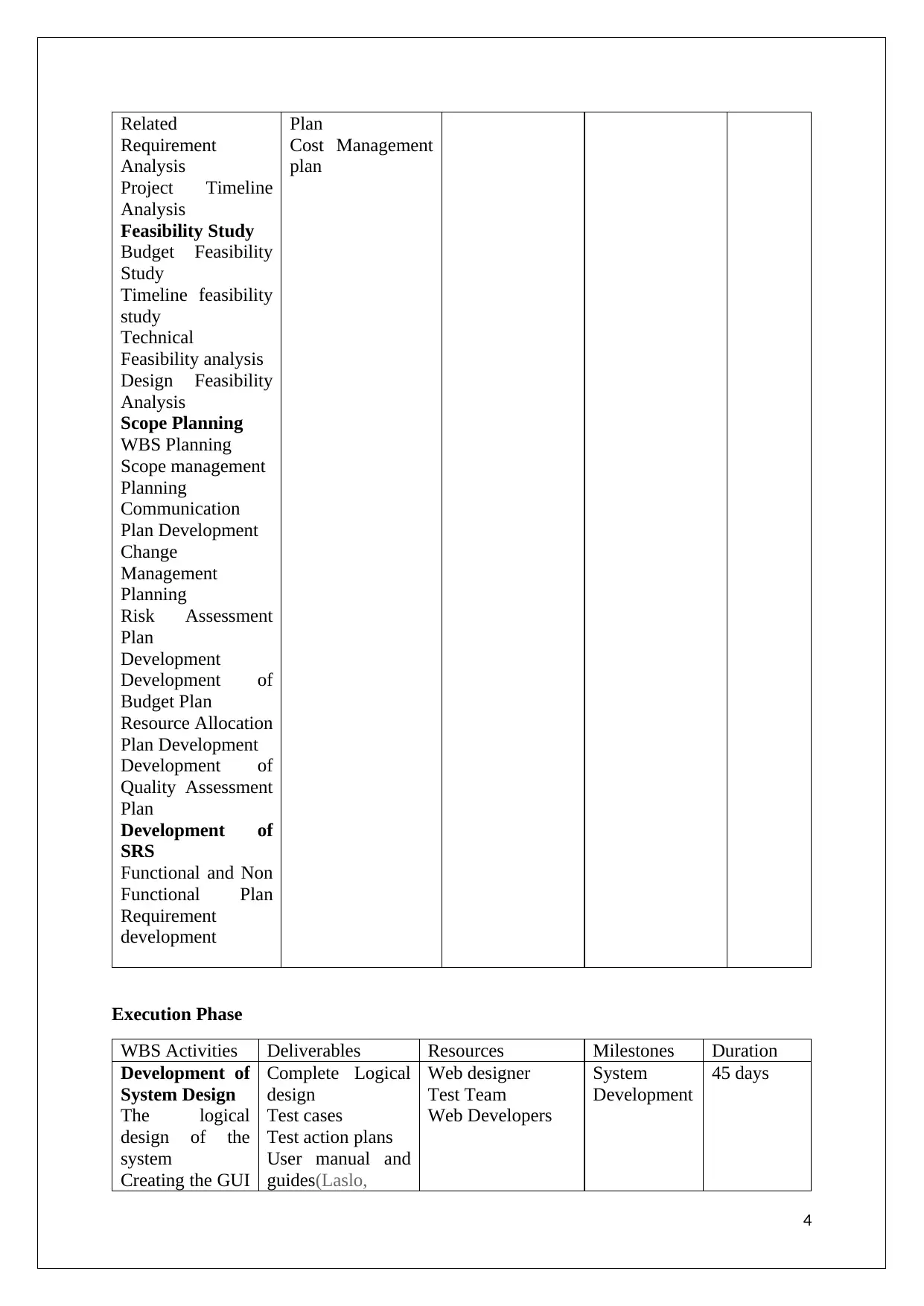
Related
Requirement
Analysis
Project Timeline
Analysis
Feasibility Study
Budget Feasibility
Study
Timeline feasibility
study
Technical
Feasibility analysis
Design Feasibility
Analysis
Scope Planning
WBS Planning
Scope management
Planning
Communication
Plan Development
Change
Management
Planning
Risk Assessment
Plan
Development
Development of
Budget Plan
Resource Allocation
Plan Development
Development of
Quality Assessment
Plan
Development of
SRS
Functional and Non
Functional Plan
Requirement
development
Plan
Cost Management
plan
Execution Phase
WBS Activities Deliverables Resources Milestones Duration
Development of
System Design
The logical
design of the
system
Creating the GUI
Complete Logical
design
Test cases
Test action plans
User manual and
guides(Laslo,
Web designer
Test Team
Web Developers
System
Development
45 days
4
Requirement
Analysis
Project Timeline
Analysis
Feasibility Study
Budget Feasibility
Study
Timeline feasibility
study
Technical
Feasibility analysis
Design Feasibility
Analysis
Scope Planning
WBS Planning
Scope management
Planning
Communication
Plan Development
Change
Management
Planning
Risk Assessment
Plan
Development
Development of
Budget Plan
Resource Allocation
Plan Development
Development of
Quality Assessment
Plan
Development of
SRS
Functional and Non
Functional Plan
Requirement
development
Plan
Cost Management
plan
Execution Phase
WBS Activities Deliverables Resources Milestones Duration
Development of
System Design
The logical
design of the
system
Creating the GUI
Complete Logical
design
Test cases
Test action plans
User manual and
guides(Laslo,
Web designer
Test Team
Web Developers
System
Development
45 days
4
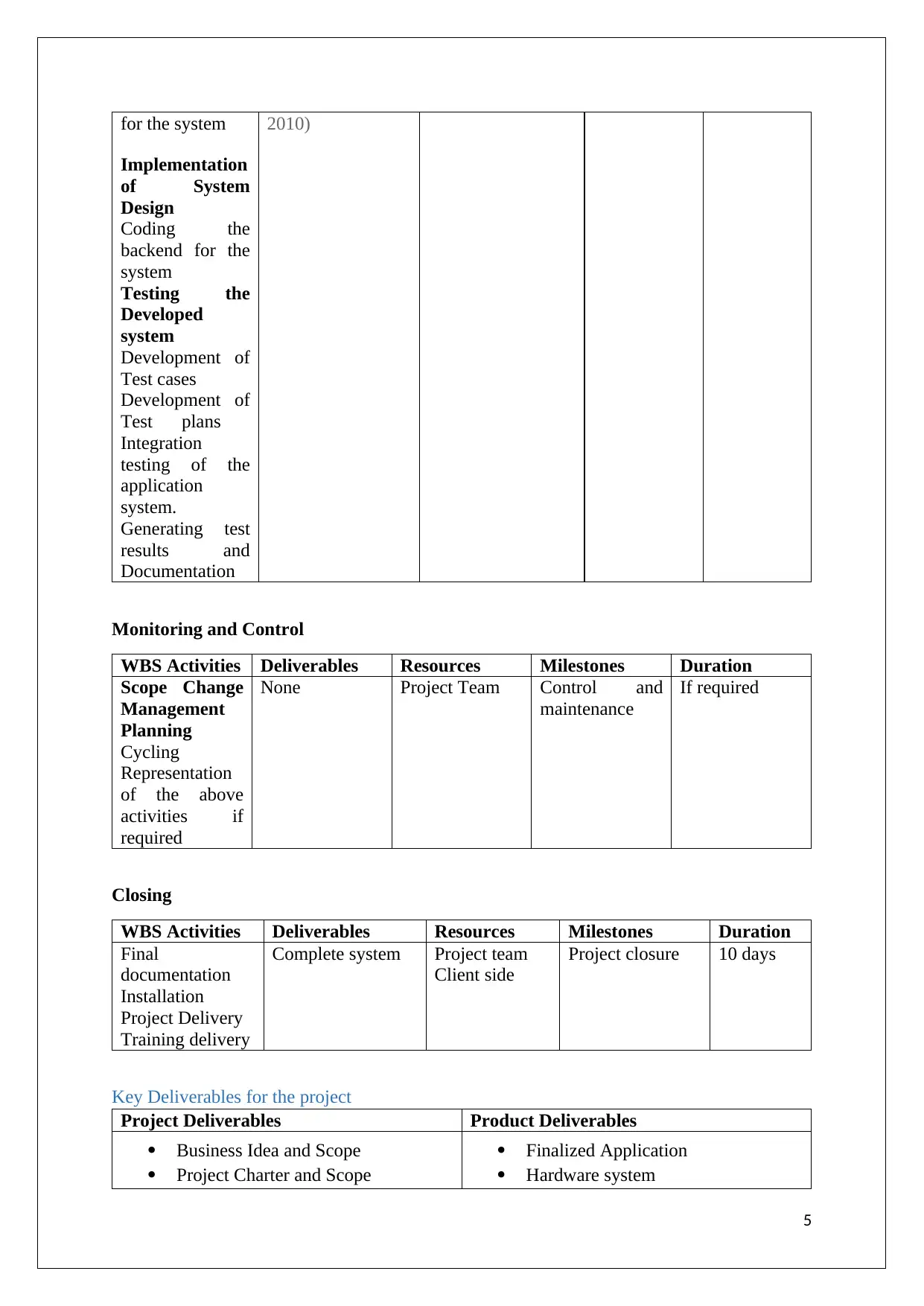
for the system
Implementation
of System
Design
Coding the
backend for the
system
Testing the
Developed
system
Development of
Test cases
Development of
Test plans
Integration
testing of the
application
system.
Generating test
results and
Documentation
2010)
Monitoring and Control
WBS Activities Deliverables Resources Milestones Duration
Scope Change
Management
Planning
Cycling
Representation
of the above
activities if
required
None Project Team Control and
maintenance
If required
Closing
WBS Activities Deliverables Resources Milestones Duration
Final
documentation
Installation
Project Delivery
Training delivery
Complete system Project team
Client side
Project closure 10 days
Key Deliverables for the project
Project Deliverables Product Deliverables
Business Idea and Scope
Project Charter and Scope
Finalized Application
Hardware system
5
Implementation
of System
Design
Coding the
backend for the
system
Testing the
Developed
system
Development of
Test cases
Development of
Test plans
Integration
testing of the
application
system.
Generating test
results and
Documentation
2010)
Monitoring and Control
WBS Activities Deliverables Resources Milestones Duration
Scope Change
Management
Planning
Cycling
Representation
of the above
activities if
required
None Project Team Control and
maintenance
If required
Closing
WBS Activities Deliverables Resources Milestones Duration
Final
documentation
Installation
Project Delivery
Training delivery
Complete system Project team
Client side
Project closure 10 days
Key Deliverables for the project
Project Deliverables Product Deliverables
Business Idea and Scope
Project Charter and Scope
Finalized Application
Hardware system
5
⊘ This is a preview!⊘
Do you want full access?
Subscribe today to unlock all pages.

Trusted by 1+ million students worldwide

SRS Document for the project
Scope Management Plan
System design document.
Service Agreements.
SRS
User manuals
Product guides.
Resources and Budget Planning:
Resource Name Key
Responsibilities Std. Rate Number of
Hours Total Cost
Project Manager and
Architect
Business
Analysis, Team
Leadership,
System Design
$ 70.00/hr 100 $7000
Web Developer
Construction of
the Web
Backend,
Database
Management
$ 40.00/hr 50 $4000
Hardware and
Networking
Manager
Construction of
Networking
Architecture of
the project
$ 40.00/hr 50 $4000
Web Designer Creation of the
GUI $ 35.00/hr 100 $3500
Test Analyst
Testing the
Developed
system
$ 35.00/hr 100 $3500
Hardware and
Resources
Printers,
Network
Routers,
Modems,
Computers
Nil Nil $8000
Project Scope Management Plan
Project Name: Business Information Management System
Prepared By: ABC
Key steps in Managing the Project Scope:
Requirement Gathering
Detailed Requirement Analysis and Elicitation
Analysis of the Requirements (Functional and Non-Functional) Requirements
Feasibility Study for the project
Cost Feasibility
Schedule Feasibility
Preparing a Scope plan for the project.
Preparing the SRS
6
Scope Management Plan
System design document.
Service Agreements.
SRS
User manuals
Product guides.
Resources and Budget Planning:
Resource Name Key
Responsibilities Std. Rate Number of
Hours Total Cost
Project Manager and
Architect
Business
Analysis, Team
Leadership,
System Design
$ 70.00/hr 100 $7000
Web Developer
Construction of
the Web
Backend,
Database
Management
$ 40.00/hr 50 $4000
Hardware and
Networking
Manager
Construction of
Networking
Architecture of
the project
$ 40.00/hr 50 $4000
Web Designer Creation of the
GUI $ 35.00/hr 100 $3500
Test Analyst
Testing the
Developed
system
$ 35.00/hr 100 $3500
Hardware and
Resources
Printers,
Network
Routers,
Modems,
Computers
Nil Nil $8000
Project Scope Management Plan
Project Name: Business Information Management System
Prepared By: ABC
Key steps in Managing the Project Scope:
Requirement Gathering
Detailed Requirement Analysis and Elicitation
Analysis of the Requirements (Functional and Non-Functional) Requirements
Feasibility Study for the project
Cost Feasibility
Schedule Feasibility
Preparing a Scope plan for the project.
Preparing the SRS
6
Paraphrase This Document
Need a fresh take? Get an instant paraphrase of this document with our AI Paraphraser
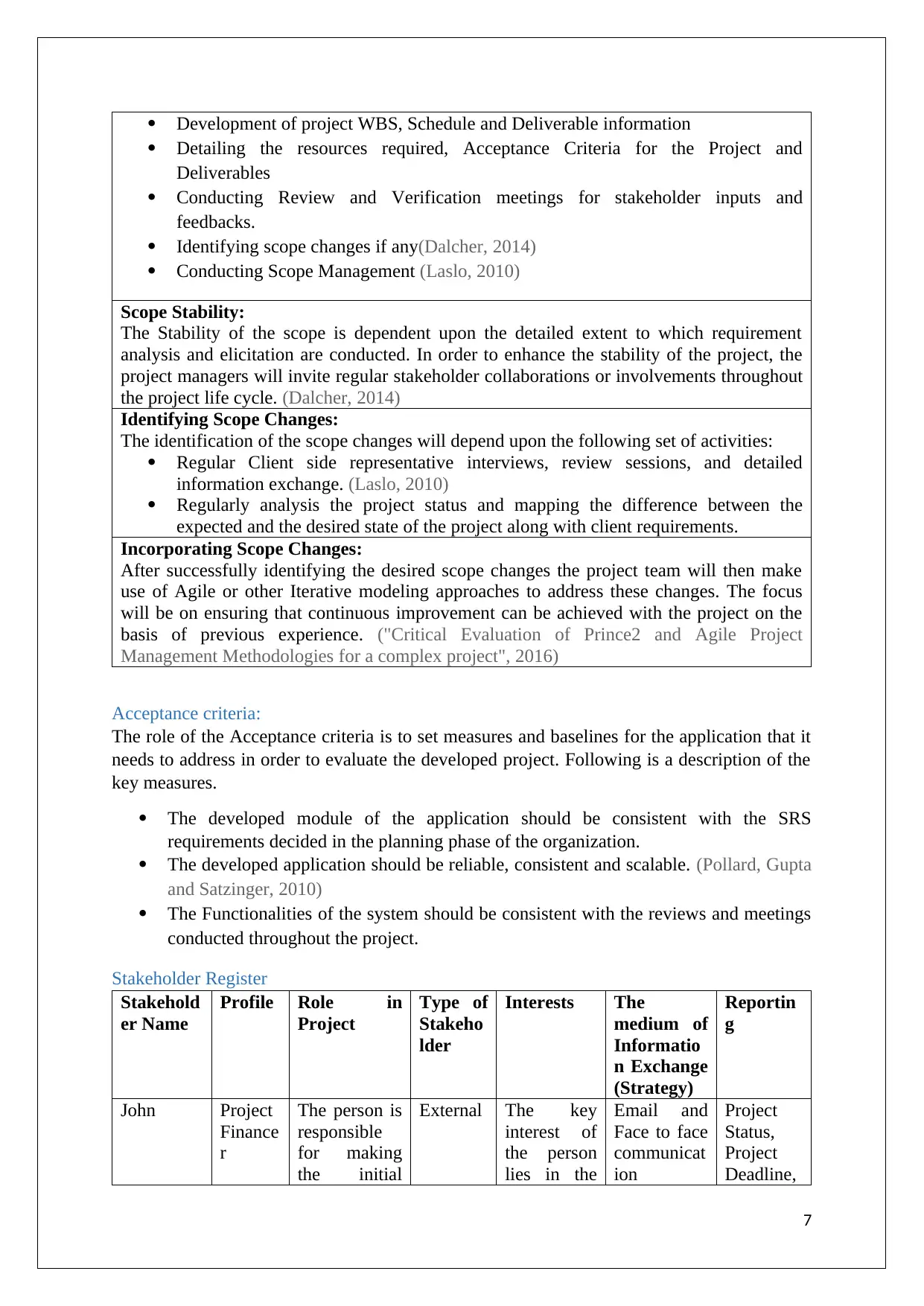
Development of project WBS, Schedule and Deliverable information
Detailing the resources required, Acceptance Criteria for the Project and
Deliverables
Conducting Review and Verification meetings for stakeholder inputs and
feedbacks.
Identifying scope changes if any(Dalcher, 2014)
Conducting Scope Management (Laslo, 2010)
Scope Stability:
The Stability of the scope is dependent upon the detailed extent to which requirement
analysis and elicitation are conducted. In order to enhance the stability of the project, the
project managers will invite regular stakeholder collaborations or involvements throughout
the project life cycle. (Dalcher, 2014)
Identifying Scope Changes:
The identification of the scope changes will depend upon the following set of activities:
Regular Client side representative interviews, review sessions, and detailed
information exchange. (Laslo, 2010)
Regularly analysis the project status and mapping the difference between the
expected and the desired state of the project along with client requirements.
Incorporating Scope Changes:
After successfully identifying the desired scope changes the project team will then make
use of Agile or other Iterative modeling approaches to address these changes. The focus
will be on ensuring that continuous improvement can be achieved with the project on the
basis of previous experience. ("Critical Evaluation of Prince2 and Agile Project
Management Methodologies for a complex project", 2016)
Acceptance criteria:
The role of the Acceptance criteria is to set measures and baselines for the application that it
needs to address in order to evaluate the developed project. Following is a description of the
key measures.
The developed module of the application should be consistent with the SRS
requirements decided in the planning phase of the organization.
The developed application should be reliable, consistent and scalable. (Pollard, Gupta
and Satzinger, 2010)
The Functionalities of the system should be consistent with the reviews and meetings
conducted throughout the project.
Stakeholder Register
Stakehold
er Name
Profile Role in
Project
Type of
Stakeho
lder
Interests The
medium of
Informatio
n Exchange
(Strategy)
Reportin
g
John Project
Finance
r
The person is
responsible
for making
the initial
External The key
interest of
the person
lies in the
Email and
Face to face
communicat
ion
Project
Status,
Project
Deadline,
7
Detailing the resources required, Acceptance Criteria for the Project and
Deliverables
Conducting Review and Verification meetings for stakeholder inputs and
feedbacks.
Identifying scope changes if any(Dalcher, 2014)
Conducting Scope Management (Laslo, 2010)
Scope Stability:
The Stability of the scope is dependent upon the detailed extent to which requirement
analysis and elicitation are conducted. In order to enhance the stability of the project, the
project managers will invite regular stakeholder collaborations or involvements throughout
the project life cycle. (Dalcher, 2014)
Identifying Scope Changes:
The identification of the scope changes will depend upon the following set of activities:
Regular Client side representative interviews, review sessions, and detailed
information exchange. (Laslo, 2010)
Regularly analysis the project status and mapping the difference between the
expected and the desired state of the project along with client requirements.
Incorporating Scope Changes:
After successfully identifying the desired scope changes the project team will then make
use of Agile or other Iterative modeling approaches to address these changes. The focus
will be on ensuring that continuous improvement can be achieved with the project on the
basis of previous experience. ("Critical Evaluation of Prince2 and Agile Project
Management Methodologies for a complex project", 2016)
Acceptance criteria:
The role of the Acceptance criteria is to set measures and baselines for the application that it
needs to address in order to evaluate the developed project. Following is a description of the
key measures.
The developed module of the application should be consistent with the SRS
requirements decided in the planning phase of the organization.
The developed application should be reliable, consistent and scalable. (Pollard, Gupta
and Satzinger, 2010)
The Functionalities of the system should be consistent with the reviews and meetings
conducted throughout the project.
Stakeholder Register
Stakehold
er Name
Profile Role in
Project
Type of
Stakeho
lder
Interests The
medium of
Informatio
n Exchange
(Strategy)
Reportin
g
John Project
Finance
r
The person is
responsible
for making
the initial
External The key
interest of
the person
lies in the
Email and
Face to face
communicat
ion
Project
Status,
Project
Deadline,
7
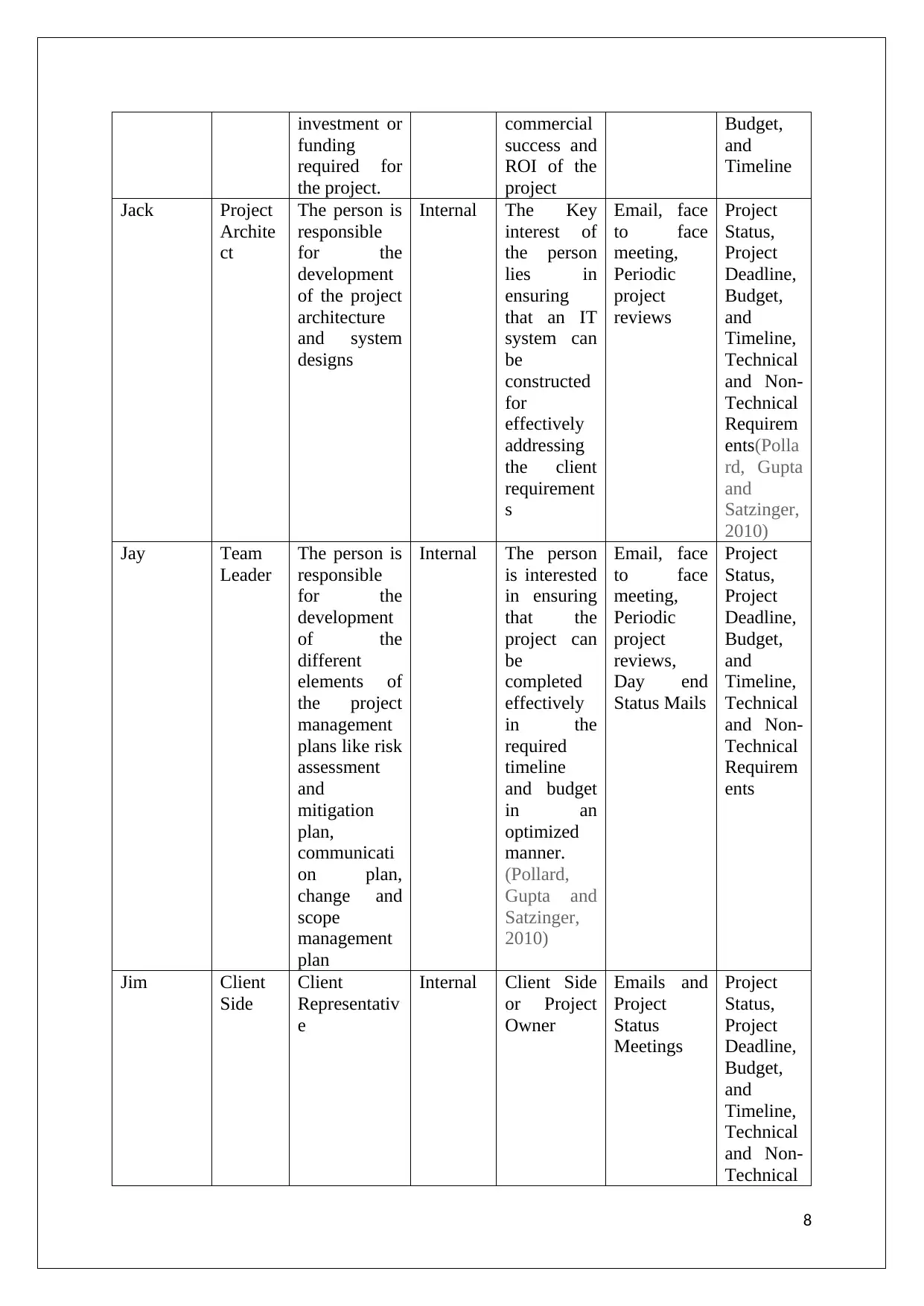
investment or
funding
required for
the project.
commercial
success and
ROI of the
project
Budget,
and
Timeline
Jack Project
Archite
ct
The person is
responsible
for the
development
of the project
architecture
and system
designs
Internal The Key
interest of
the person
lies in
ensuring
that an IT
system can
be
constructed
for
effectively
addressing
the client
requirement
s
Email, face
to face
meeting,
Periodic
project
reviews
Project
Status,
Project
Deadline,
Budget,
and
Timeline,
Technical
and Non-
Technical
Requirem
ents(Polla
rd, Gupta
and
Satzinger,
2010)
Jay Team
Leader
The person is
responsible
for the
development
of the
different
elements of
the project
management
plans like risk
assessment
and
mitigation
plan,
communicati
on plan,
change and
scope
management
plan
Internal The person
is interested
in ensuring
that the
project can
be
completed
effectively
in the
required
timeline
and budget
in an
optimized
manner.
(Pollard,
Gupta and
Satzinger,
2010)
Email, face
to face
meeting,
Periodic
project
reviews,
Day end
Status Mails
Project
Status,
Project
Deadline,
Budget,
and
Timeline,
Technical
and Non-
Technical
Requirem
ents
Jim Client
Side
Client
Representativ
e
Internal Client Side
or Project
Owner
Emails and
Project
Status
Meetings
Project
Status,
Project
Deadline,
Budget,
and
Timeline,
Technical
and Non-
Technical
8
funding
required for
the project.
commercial
success and
ROI of the
project
Budget,
and
Timeline
Jack Project
Archite
ct
The person is
responsible
for the
development
of the project
architecture
and system
designs
Internal The Key
interest of
the person
lies in
ensuring
that an IT
system can
be
constructed
for
effectively
addressing
the client
requirement
s
Email, face
to face
meeting,
Periodic
project
reviews
Project
Status,
Project
Deadline,
Budget,
and
Timeline,
Technical
and Non-
Technical
Requirem
ents(Polla
rd, Gupta
and
Satzinger,
2010)
Jay Team
Leader
The person is
responsible
for the
development
of the
different
elements of
the project
management
plans like risk
assessment
and
mitigation
plan,
communicati
on plan,
change and
scope
management
plan
Internal The person
is interested
in ensuring
that the
project can
be
completed
effectively
in the
required
timeline
and budget
in an
optimized
manner.
(Pollard,
Gupta and
Satzinger,
2010)
Email, face
to face
meeting,
Periodic
project
reviews,
Day end
Status Mails
Project
Status,
Project
Deadline,
Budget,
and
Timeline,
Technical
and Non-
Technical
Requirem
ents
Jim Client
Side
Client
Representativ
e
Internal Client Side
or Project
Owner
Emails and
Project
Status
Meetings
Project
Status,
Project
Deadline,
Budget,
and
Timeline,
Technical
and Non-
Technical
8
⊘ This is a preview!⊘
Do you want full access?
Subscribe today to unlock all pages.

Trusted by 1+ million students worldwide

Requirem
ents
Risk Assessment Plan
Throughout the project lifecycle, the project has to pass through a number of different phases,
activities, and tasks. During these stages, the project might encounter certain risks or
anomalies that might impact the chances of success for a project. (Rozenes, 2011)
The following plan describes how risk will be assessed and measured in the project’ scope.
Possible Risk Areas:
Failing to address the project requirements and Functionalities.
Inability to complete the project on time.
Failing to address the project scope.
Inability to complete the project within the given budget.
Inability to address the project scope changes. (Rozenes, 2011)
Risk Indicators
Diversion from the Project timeline
Diversion from the project WBS
Conflicting Project Reviews
Conflicting team meetings and review sessions.
Diversion from the project Cost or budget estimation
Assessment and Mitigation Approach
Detailed Requirement Analysis and Elicitation to ensure that the project team has
relevant information for making the project management plans, timelines and
costings. (Wells, 2012)
1. Clear Requirement Definition
2. Development of structured scope
Structured Feasibility study to ensure that the requirements can be practically
addressed.
Selection and Implementation of a well-structured project management approach to
address the project scope and changes. (Wells, 2012)
Building up a structured and reliable team environment.
Regular Client Meetings and feedback sessions for better scope management.
("Critical Evaluation of Prince2 and Agile Project Management Methodologies for a complex
project", 2016)
Communication Management and Project Control
Project monitoring and control is one of the most crucial phases in the life cycle of project
development. The core focus of the project is to map the progress and ensure that the current
status of the project in terms of timeline, budget, and functionalities implemented are
consistent with the project’ requirements and scope. It helps the organization or the project
team to ensure that they will be able to address the scope of the project in an optimized and
effective manner. Regular monitoring of the project status helps the project manager to
identify the key addressable areas, the requirement of changes and the possible list of threats
that can disrupt the flow of the project. (Bhatnagar and Kumar Singh, 2013) Further, In order
to ensure that the project is being monitored and evaluated effectively, it is important that
consistent information or knowledge is being shared with the stakeholders. In other words,
information exchange and knowledge transfer are one of the most important aspects of
management or control activities of any project. Hence, management of the communication
9
ents
Risk Assessment Plan
Throughout the project lifecycle, the project has to pass through a number of different phases,
activities, and tasks. During these stages, the project might encounter certain risks or
anomalies that might impact the chances of success for a project. (Rozenes, 2011)
The following plan describes how risk will be assessed and measured in the project’ scope.
Possible Risk Areas:
Failing to address the project requirements and Functionalities.
Inability to complete the project on time.
Failing to address the project scope.
Inability to complete the project within the given budget.
Inability to address the project scope changes. (Rozenes, 2011)
Risk Indicators
Diversion from the Project timeline
Diversion from the project WBS
Conflicting Project Reviews
Conflicting team meetings and review sessions.
Diversion from the project Cost or budget estimation
Assessment and Mitigation Approach
Detailed Requirement Analysis and Elicitation to ensure that the project team has
relevant information for making the project management plans, timelines and
costings. (Wells, 2012)
1. Clear Requirement Definition
2. Development of structured scope
Structured Feasibility study to ensure that the requirements can be practically
addressed.
Selection and Implementation of a well-structured project management approach to
address the project scope and changes. (Wells, 2012)
Building up a structured and reliable team environment.
Regular Client Meetings and feedback sessions for better scope management.
("Critical Evaluation of Prince2 and Agile Project Management Methodologies for a complex
project", 2016)
Communication Management and Project Control
Project monitoring and control is one of the most crucial phases in the life cycle of project
development. The core focus of the project is to map the progress and ensure that the current
status of the project in terms of timeline, budget, and functionalities implemented are
consistent with the project’ requirements and scope. It helps the organization or the project
team to ensure that they will be able to address the scope of the project in an optimized and
effective manner. Regular monitoring of the project status helps the project manager to
identify the key addressable areas, the requirement of changes and the possible list of threats
that can disrupt the flow of the project. (Bhatnagar and Kumar Singh, 2013) Further, In order
to ensure that the project is being monitored and evaluated effectively, it is important that
consistent information or knowledge is being shared with the stakeholders. In other words,
information exchange and knowledge transfer are one of the most important aspects of
management or control activities of any project. Hence, management of the communication
9
Paraphrase This Document
Need a fresh take? Get an instant paraphrase of this document with our AI Paraphraser
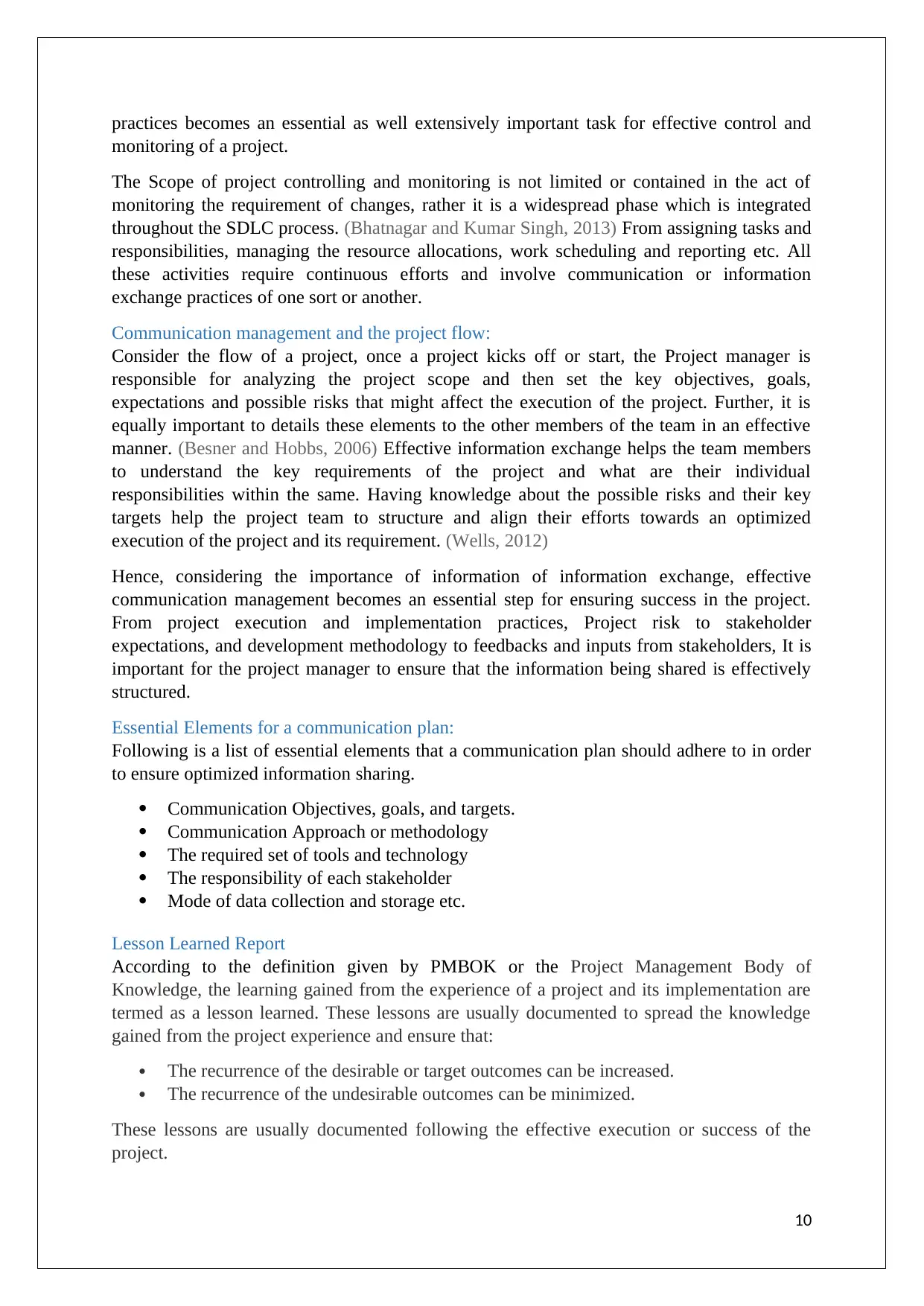
practices becomes an essential as well extensively important task for effective control and
monitoring of a project.
The Scope of project controlling and monitoring is not limited or contained in the act of
monitoring the requirement of changes, rather it is a widespread phase which is integrated
throughout the SDLC process. (Bhatnagar and Kumar Singh, 2013) From assigning tasks and
responsibilities, managing the resource allocations, work scheduling and reporting etc. All
these activities require continuous efforts and involve communication or information
exchange practices of one sort or another.
Communication management and the project flow:
Consider the flow of a project, once a project kicks off or start, the Project manager is
responsible for analyzing the project scope and then set the key objectives, goals,
expectations and possible risks that might affect the execution of the project. Further, it is
equally important to details these elements to the other members of the team in an effective
manner. (Besner and Hobbs, 2006) Effective information exchange helps the team members
to understand the key requirements of the project and what are their individual
responsibilities within the same. Having knowledge about the possible risks and their key
targets help the project team to structure and align their efforts towards an optimized
execution of the project and its requirement. (Wells, 2012)
Hence, considering the importance of information of information exchange, effective
communication management becomes an essential step for ensuring success in the project.
From project execution and implementation practices, Project risk to stakeholder
expectations, and development methodology to feedbacks and inputs from stakeholders, It is
important for the project manager to ensure that the information being shared is effectively
structured.
Essential Elements for a communication plan:
Following is a list of essential elements that a communication plan should adhere to in order
to ensure optimized information sharing.
Communication Objectives, goals, and targets.
Communication Approach or methodology
The required set of tools and technology
The responsibility of each stakeholder
Mode of data collection and storage etc.
Lesson Learned Report
According to the definition given by PMBOK or the Project Management Body of
Knowledge, the learning gained from the experience of a project and its implementation are
termed as a lesson learned. These lessons are usually documented to spread the knowledge
gained from the project experience and ensure that:
The recurrence of the desirable or target outcomes can be increased.
The recurrence of the undesirable outcomes can be minimized.
These lessons are usually documented following the effective execution or success of the
project.
10
monitoring of a project.
The Scope of project controlling and monitoring is not limited or contained in the act of
monitoring the requirement of changes, rather it is a widespread phase which is integrated
throughout the SDLC process. (Bhatnagar and Kumar Singh, 2013) From assigning tasks and
responsibilities, managing the resource allocations, work scheduling and reporting etc. All
these activities require continuous efforts and involve communication or information
exchange practices of one sort or another.
Communication management and the project flow:
Consider the flow of a project, once a project kicks off or start, the Project manager is
responsible for analyzing the project scope and then set the key objectives, goals,
expectations and possible risks that might affect the execution of the project. Further, it is
equally important to details these elements to the other members of the team in an effective
manner. (Besner and Hobbs, 2006) Effective information exchange helps the team members
to understand the key requirements of the project and what are their individual
responsibilities within the same. Having knowledge about the possible risks and their key
targets help the project team to structure and align their efforts towards an optimized
execution of the project and its requirement. (Wells, 2012)
Hence, considering the importance of information of information exchange, effective
communication management becomes an essential step for ensuring success in the project.
From project execution and implementation practices, Project risk to stakeholder
expectations, and development methodology to feedbacks and inputs from stakeholders, It is
important for the project manager to ensure that the information being shared is effectively
structured.
Essential Elements for a communication plan:
Following is a list of essential elements that a communication plan should adhere to in order
to ensure optimized information sharing.
Communication Objectives, goals, and targets.
Communication Approach or methodology
The required set of tools and technology
The responsibility of each stakeholder
Mode of data collection and storage etc.
Lesson Learned Report
According to the definition given by PMBOK or the Project Management Body of
Knowledge, the learning gained from the experience of a project and its implementation are
termed as a lesson learned. These lessons are usually documented to spread the knowledge
gained from the project experience and ensure that:
The recurrence of the desirable or target outcomes can be increased.
The recurrence of the undesirable outcomes can be minimized.
These lessons are usually documented following the effective execution or success of the
project.
10
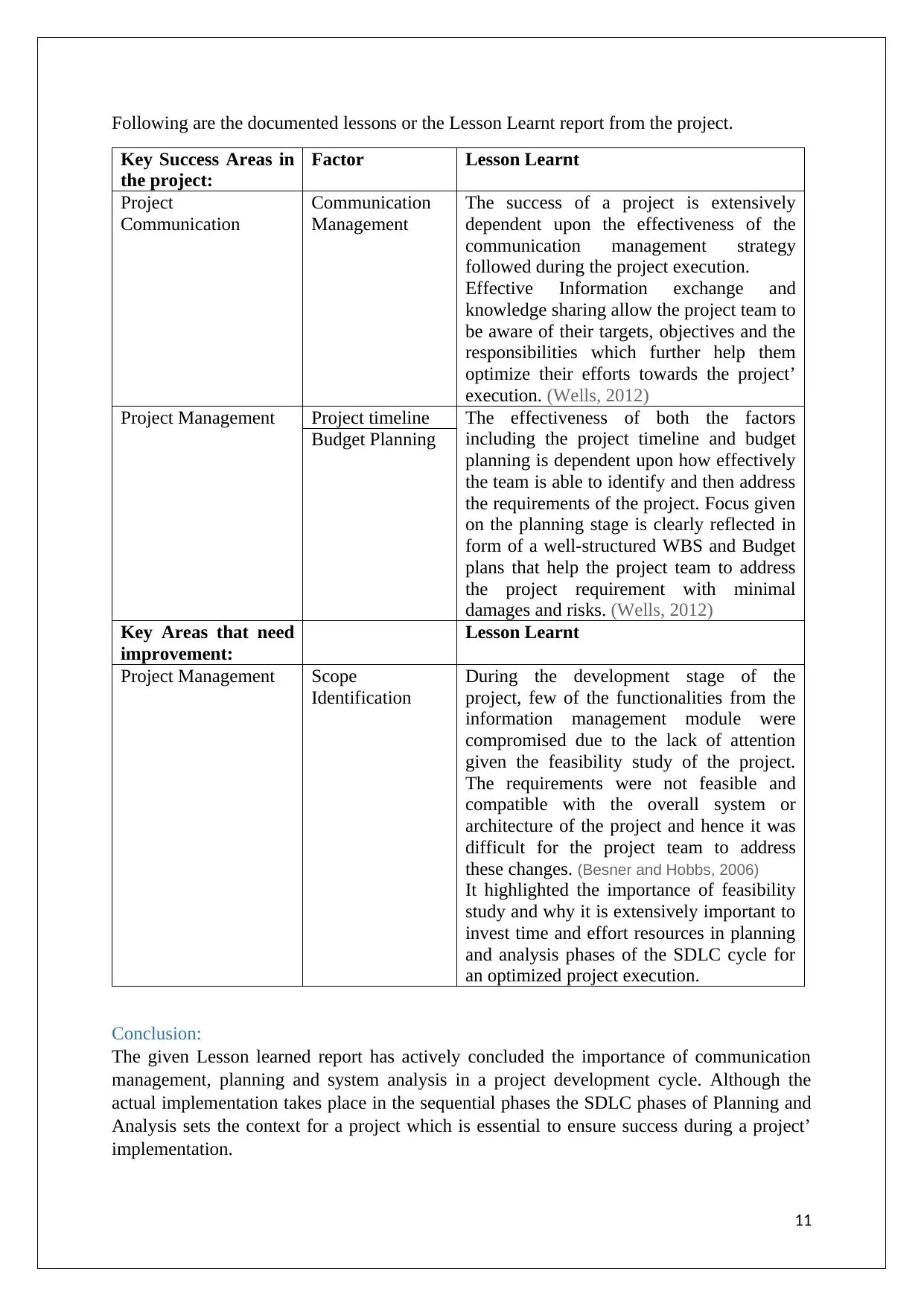
Following are the documented lessons or the Lesson Learnt report from the project.
Key Success Areas in
the project:
Factor Lesson Learnt
Project
Communication
Communication
Management
The success of a project is extensively
dependent upon the effectiveness of the
communication management strategy
followed during the project execution.
Effective Information exchange and
knowledge sharing allow the project team to
be aware of their targets, objectives and the
responsibilities which further help them
optimize their efforts towards the project’
execution. (Wells, 2012)
Project Management Project timeline The effectiveness of both the factors
including the project timeline and budget
planning is dependent upon how effectively
the team is able to identify and then address
the requirements of the project. Focus given
on the planning stage is clearly reflected in
form of a well-structured WBS and Budget
plans that help the project team to address
the project requirement with minimal
damages and risks. (Wells, 2012)
Budget Planning
Key Areas that need
improvement:
Lesson Learnt
Project Management Scope
Identification
During the development stage of the
project, few of the functionalities from the
information management module were
compromised due to the lack of attention
given the feasibility study of the project.
The requirements were not feasible and
compatible with the overall system or
architecture of the project and hence it was
difficult for the project team to address
these changes. (Besner and Hobbs, 2006)
It highlighted the importance of feasibility
study and why it is extensively important to
invest time and effort resources in planning
and analysis phases of the SDLC cycle for
an optimized project execution.
Conclusion:
The given Lesson learned report has actively concluded the importance of communication
management, planning and system analysis in a project development cycle. Although the
actual implementation takes place in the sequential phases the SDLC phases of Planning and
Analysis sets the context for a project which is essential to ensure success during a project’
implementation.
11
Key Success Areas in
the project:
Factor Lesson Learnt
Project
Communication
Communication
Management
The success of a project is extensively
dependent upon the effectiveness of the
communication management strategy
followed during the project execution.
Effective Information exchange and
knowledge sharing allow the project team to
be aware of their targets, objectives and the
responsibilities which further help them
optimize their efforts towards the project’
execution. (Wells, 2012)
Project Management Project timeline The effectiveness of both the factors
including the project timeline and budget
planning is dependent upon how effectively
the team is able to identify and then address
the requirements of the project. Focus given
on the planning stage is clearly reflected in
form of a well-structured WBS and Budget
plans that help the project team to address
the project requirement with minimal
damages and risks. (Wells, 2012)
Budget Planning
Key Areas that need
improvement:
Lesson Learnt
Project Management Scope
Identification
During the development stage of the
project, few of the functionalities from the
information management module were
compromised due to the lack of attention
given the feasibility study of the project.
The requirements were not feasible and
compatible with the overall system or
architecture of the project and hence it was
difficult for the project team to address
these changes. (Besner and Hobbs, 2006)
It highlighted the importance of feasibility
study and why it is extensively important to
invest time and effort resources in planning
and analysis phases of the SDLC cycle for
an optimized project execution.
Conclusion:
The given Lesson learned report has actively concluded the importance of communication
management, planning and system analysis in a project development cycle. Although the
actual implementation takes place in the sequential phases the SDLC phases of Planning and
Analysis sets the context for a project which is essential to ensure success during a project’
implementation.
11
⊘ This is a preview!⊘
Do you want full access?
Subscribe today to unlock all pages.

Trusted by 1+ million students worldwide
1 out of 14
Related Documents
Your All-in-One AI-Powered Toolkit for Academic Success.
+13062052269
info@desklib.com
Available 24*7 on WhatsApp / Email
![[object Object]](/_next/static/media/star-bottom.7253800d.svg)
Unlock your academic potential
Copyright © 2020–2025 A2Z Services. All Rights Reserved. Developed and managed by ZUCOL.




